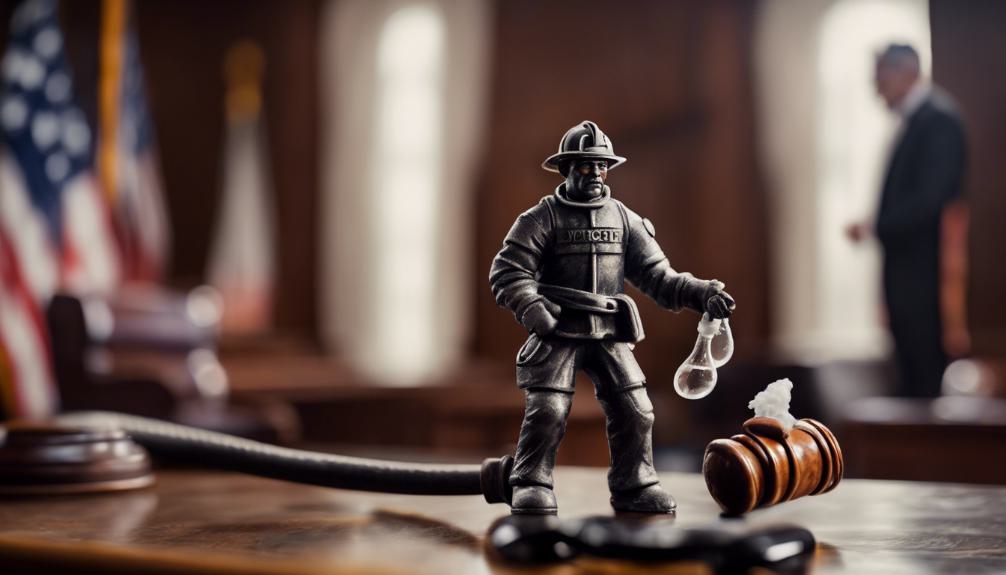Firefighting Foam Sparks Legal Battles
The legal controversies surrounding Aqueous Film-Forming Foam (AFFF) have brought to light a critical debate over the balance between firefighting efficacy and environmental health. As lawsuits proliferate across jurisdictions, plaintiffs argue that the incorporation of PFAS chemicals, despite their fire-suppressing capabilities, exposes communities and ecosystems to significant risks. This evolving legal saga not only questions the accountability of manufacturers and users but also examines the regulatory frameworks governing chemical use in firefighting. As the courtrooms become battlegrounds for these complex issues, one wonders about the future of firefighting foams and the implications for public health and safety standards.

Key Takeaways
- AFFF firefighting foam is linked to cancer due to PFAS chemicals.
- Environmental and human health risks prompt legal actions against AFFF manufacturers.
- Occupations with high AFFF exposure are central to ongoing lawsuits.
- Lawsuits focus on compensation for health impacts from AFFF exposure.
AFFF Foam Overview

Aqueous Film-Forming Foam (AFFF) is a synthetic, water-based solution specifically designed to extinguish Class B fires, which involve flammable liquids and gases. Esteemed for its effectiveness, AFFF has been a crucial tool in safeguarding lives and property during emergencies. Its unique foam applications allow it to spread over the surface of flammable liquids, forming a barrier that smothers the fire and prevents re-ignition. However, the presence of per- and polyfluoroalkyl substances (PFAS) in AFFF has led to stringent PFAS regulation aimed at minimizing environmental and health risks. These regulations guide the responsible use and disposal of AFFF, ensuring that those dedicated to serving others can continue to do so while mitigating potential harm to health and the environment.
PFAS Chemical Concerns

Increasingly, concerns about the environmental and health ramifications of per- and polyfluoroalkyl substances (PFAS) found in AFFF have prompted rigorous scientific scrutiny and regulatory action. As awareness of the potential toxic exposure from these chemicals grows, communities and professionals dedicated to serving others are advocating for stricter PFAS regulation. This movement is driven by a commitment to prevent harm and safeguard public health, emphasizing the need for comprehensive research to understand the full extent of PFAS impacts. Efforts to mitigate exposure and implement safer alternatives are gaining momentum, reflecting a collective determination to address these concerns responsibly. The call for action underscores a shared responsibility to protect those most vulnerable to the adverse effects of PFAS, ensuring a healthier environment for future generations.
Health Risks Identified

Research into PFAS chemicals, specifically those found in AFFF, has uncovered significant health risks, including a heightened risk of cancer and other serious diseases. These findings have propelled a sense of urgency among those devoted to public health and safety. Continuous exposure to these substances, even in small quantities, can lead to accumulating levels in the human body, significantly increasing cancer risks. Particularly alarming are the connections between PFAS exposure and the development of testicular and kidney cancer, among other conditions. For those in service-oriented professions, especially firefighters, the call to action is clear: to safeguard themselves and the communities they serve by pushing for safer alternatives and stringent regulations on hazardous substances. The battle against PFAS exposure is not just a legal fight but a moral imperative.
Environmental Contamination

The pervasive use of AFFF firefighting foam has led to widespread environmental contamination, affecting soil, water bodies, and ecosystems. This contamination is particularly concerning for water contamination and groundwater pollution, posing a significant threat to both human health and environmental integrity. The presence of PFAS chemicals, once hailed for their firefighting efficacy, has now become a source of deep concern due to their persistence in the environment and potential to accumulate in the human body. Efforts to address and remediate these contaminants are crucial for protecting community water supplies and preserving natural habitats. For those dedicated to serving others and safeguarding our planet, understanding and combating this contamination is a paramount concern, highlighting the necessity for stringent environmental protections and remediation efforts.
Occupational Exposure Risks

Given the pervasive environmental contamination linked to AFFF, it is crucial to examine the specific risks faced by individuals in occupations that frequently use this firefighting foam. Those dedicated to serving others, such as firefighters, military personnel, and airport workers, are at the forefront of exposure to hazardous chemicals contained in AFFF, including PFAS compounds known for their adverse health effects. To safeguard these vital community members, a thorough risk assessment is imperative. This process involves identifying exposure levels, understanding potential health impacts, and implementing effective protective measures. By doing so, we not only protect those who protect us but also contribute to a broader understanding of occupational safety in environments where AFFF use is essential.
Recent Lawsuit Updates

Several recent legal developments have significantly impacted the landscape of litigation surrounding AFFF, highlighting the ongoing battle against the harmful effects of PFAS chemicals. These developments include:
- Notable Settlement Increases: Recent cases have seen a marked rise in settlement amounts, reflecting a growing acknowledgment of the health risks posed by PFAS exposure.
- Expansion of Litigants: A broader range of individuals, including military personnel and airport workers, have initiated litigation, seeking compensation for exposure-related illnesses.
- Advancements in Scientific Evidence: Enhanced scientific understanding of PFAS health impacts has bolstered litigation outcomes, enabling more favorable rulings for affected parties.
- Policy Shifts Prompting Litigation: Regulatory changes and increased scrutiny of PFAS chemicals have fueled a surge in lawsuits, challenging both manufacturers and users of AFFF products.
These developments underscore significant trends in settlement and litigation outcomes, reflecting a collective effort to address the consequences of PFAS exposure.
Lawsuit Eligibility Criteria

Understanding the criteria for lawsuit eligibility is crucial for those exposed to AFFF and suffering from related health conditions. The legal landscape surrounding AFFF litigation underscores the importance of recognizing occupational hazards and adhering to specific legal requirements. Individuals who have encountered AFFF through their work environments, especially firefighters, military personnel, and airport workers, need to ascertain their exposure level and document any resultant health issues meticulously. The eligibility criteria for initiating a lawsuit include proven exposure to AFFF and a diagnosis of serious illnesses, notably cancers linked to PFAS chemicals. It is essential for affected individuals to comprehend these criteria fully, as they form the foundation of a legal claim against the manufacturers of AFFF, highlighting the intersection of occupational safety and legal recourse in addressing the adverse effects of hazardous substances.
Legal Process Explained

Having established the eligibility criteria for AFFF lawsuits, it is crucial to navigate the legal process involved in filing a claim. This involves understanding the lawsuit procedures and court proceedings, which can be complex but are vital for those seeking justice. Here's a brief overview:
- Consultation with a Lawyer: Engage an experienced attorney to evaluate your case.
- Filing the Lawsuit: Your lawyer will file a complaint in federal or state court, initiating the legal process.
- Discovery Phase: Both parties exchange information and evidence related to the case.
- Court Proceedings: The case may go to trial, where arguments will be heard, and a decision made.
For those desiring to serve others by pursuing justice, understanding these steps is paramount in navigating the legal system effectively.
Settlement Factors

Determining the settlement amounts in AFFF litigation involves evaluating various factors, including the severity of the injuries and the circumstances of exposure. The ultimate goal is to ensure that those affected receive fair compensation, reflecting the impact on their lives. Notably, the exposure duration plays a crucial role in calculating compensation amounts.
| Factor | Consideration in Settlements |
|---|---|
| Severity of Injuries | Directly influences compensation |
| Exposure Duration | Longer exposure can increase amounts |
| Circumstances of Exposure | Context of exposure affects outcomes |
| Medical Expenses | Included in compensation calculations |
| Impact on Quality of Life | Assessed to determine fair compensation |
Ensuring justice for those harmed by AFFF exposure requires a comprehensive evaluation of these factors to arrive at just compensation amounts.
Filing A Lawsuit

After evaluating the factors that influence settlement amounts in AFFF litigation, individuals impacted by exposure must next consider the legal steps required to file a lawsuit. Engaging in this process can seem daunting, but with the right legal representation, the path towards compensation claims becomes clearer. Here is a concise guide:
- Consult with specialized attorneys who have experience in AFFF litigation to assess your case.
- Gather and document evidence of exposure and related health issues.
- Understand the statute of limitations in your jurisdiction to ensure timely filing.
- Prepare for a detailed legal process, including discovery, pre-trial motions, and possibly a trial.
Seeking justice through legal avenues offers not just potential compensation but also contributes to the broader effort of holding responsible parties accountable for public health and environmental damages.
Future Implications

The evolving legal landscape surrounding AFFF litigation could set significant precedents for future environmental and health-related lawsuits.
| Aspect | Implications | Potential Actions |
|---|---|---|
| Regulatory Changes | Stricter regulations on PFAS | Review and adjust usage policies |
| Industry Response | Adoption of safer alternatives | Increase in R&D for non-PFAS foams |
| Legal Precedents | Framework for future litigation | Guided approach for similar cases |
These shifts point toward a future where protecting health and the environment is paramount. In moving forward, the collective effort to address these issues, driven by regulatory changes and industry response, will undoubtedly shape our approach to firefighting solutions and influence the broader environmental health landscape. This journey is not just about rectifying past oversights but about paving a safer, more informed path forward.

This post has been generated by AI and was not reviewed by editors. This is Not legal advice. Please consult with an attorney.




